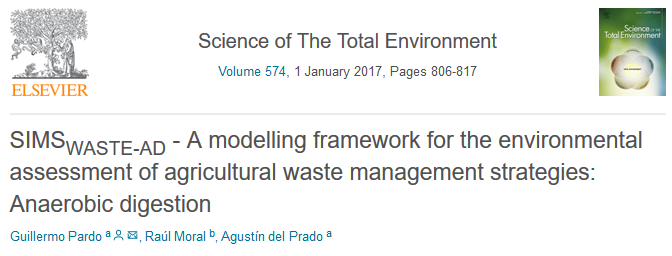BC3 Journal Article “SIMSWASTE-AD – A modelling framework for the environmental assessment of agricultural waste management strategies: Anaerobic digestion”


Go to external source
Pardo. G., Moral. R., and del Prado, A. 2017. SIMSWASTE-AD – A modelling framework for the environmental assessment of agricultural waste management strategies: Anaerobic digestion. Science Of The Total Environment. 574. 806-817. DOI (10.1016/j.scitotenv.2016.09.096)
Abstract
On-farm anaerobic digestion (AD) has been promoted due to its improved environmental performance, which is based on a number of life cycle assessments (LCA). However, the influence of site-specific conditions and practices on AD performance is rarely captured in LCA studies and the effects on C and N cycles are often overlooked. In this paper, a new model for AD (SIMSWASTE-AD) is described in full and tested against a selection of available measured data. Good agreement between modelled and measured values was obtained, reflecting the model capability to predict biogas production (r2 = 0.84) and N mineralization (r2 = 0.85) under a range of substrate mixtures and operational conditions. SIMSWASTE-AD was also used to simulate C and N flows and GHG emissions for a set of scenarios exploring different AD technology levels, feedstock mixtures and climate conditions. The importance of post-digestion emissions and its relationship with the AD performance have been stressed as crucial factors to reduce the net GHG emissions (− 75%) but also to enhance digestate fertilizer potential (15%). Gas tight digestate storage with residual biogas collection is highly recommended (especially in temperate to warm climates), as well as those operational conditions that can improve the process efficiency on degrading VS (e.g. thermophilic range, longer hydraulic retention time). Beyond the effects on the manure management stage, SIMSWASTE-AD also aims to help account for potential effects of AD on other stages by providing the C and nutrient flows. While primarily designed to be applied within the SIMSDAIRY modelling framework, it can also interact with other models implemented in integrated approaches. Such system scope assessments are essential for stakeholders and policy makers in order to develop effective strategies for reducing GHG emissions and environmental issues in the agriculture sector.
